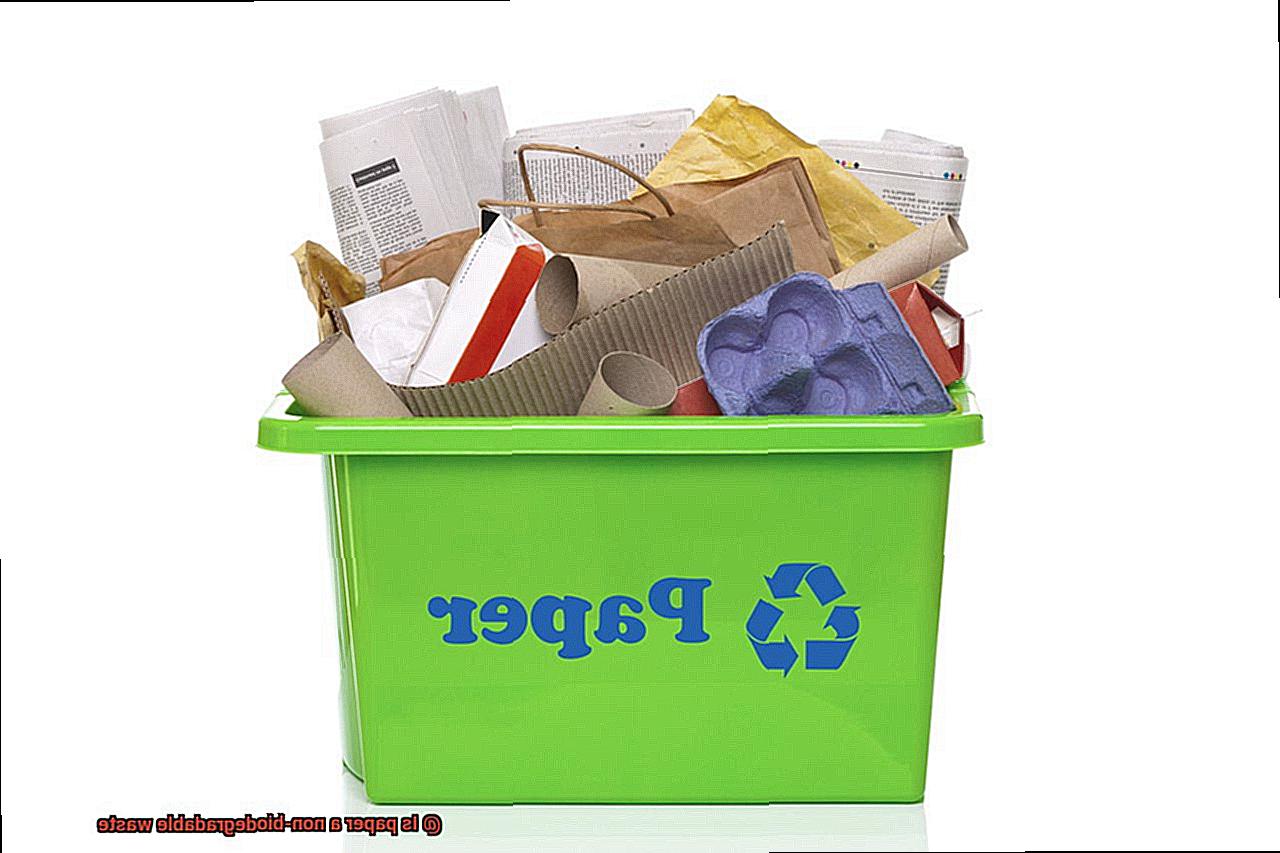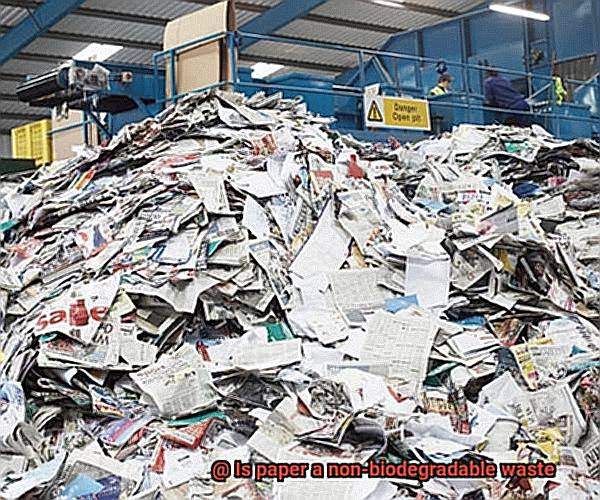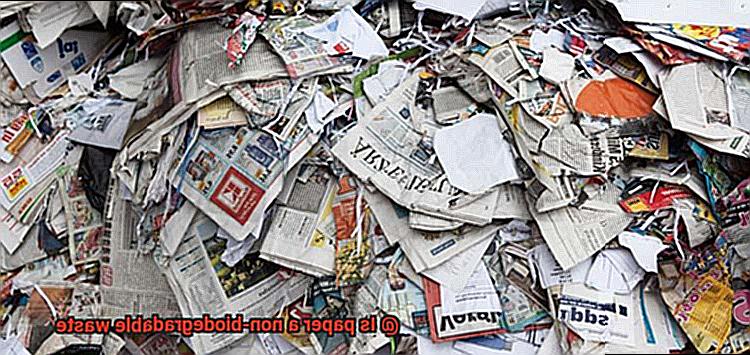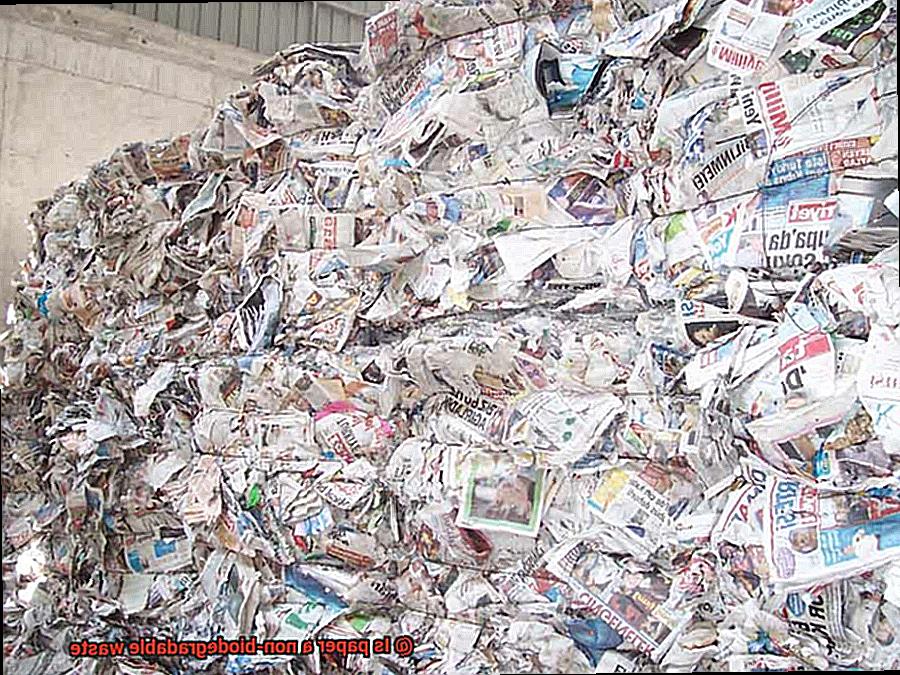Waste management has become a hot topic in recent years, and it’s not hard to see why. With overflowing landfills and plastic pollution in our oceans, it’s clear that we need to take action. But what about the impact of paper waste on the environment?
We use paper every day, from writing notes to wrapping gifts. It’s a versatile material that’s been around for centuries. However, as with any product, its production and disposal have consequences. So, is paper a non-biodegradable waste?
At first glance, you might assume that paper is biodegradable since it comes from trees. But the manufacturing process involves chemicals that reduce its ability to decompose naturally. And if not disposed of correctly, paper can cause environmental problems.
In this blog post, we’ll explore everything you need to know about paper waste – from how it’s made to its impact on the environment. We’ll also share tips on how you can reduce your paper consumption and recycle effectively.
Let’s get started.
Is Paper Biodegradable?
Contents
The process of turning wood pulp into paper often involves adding chemicals and substances that can impact its natural breakdown.
For example, bleach is commonly used to make paper brighter and whiter, but chlorine bleach can leave behind harmful chemicals that can harm the environment and slow down biodegradation. Additionally, glossy or coated papers may contain plastic or other non-biodegradable materials that can further impede the biodegradation process.
Despite these potential obstacles, paper can still break down over time when exposed to the right conditions such as moisture, oxygen, and microorganisms like bacteria and fungi. This process is known as biodegradation and results in the release of carbon dioxide and other organic compounds back into the ecosystem.
It’s important to note that different types of paper will biodegrade at different rates based on factors such as thickness or processing. The environmental conditions such as temperature, humidity, and acidity levels can also impact how quickly or effectively paper will biodegrade.
While paper may not be a perfect example of a biodegradable material due to its manufacturing processes and potential additives, it’s still considered a relatively eco-friendly choice compared to non-biodegradable materials like plastic or metal.
By choosing recycled or unbleached paper products and properly disposing of them through composting or recycling programs, individuals can help facilitate the natural biodegradation of paper waste and reduce their environmental impact.
Factors Affecting the Degradation of Paper
The answer is not straightforward, as the degradation of paper is affected by several factors.

Let’s dive into the three main factors affecting the degradation of paper: type, environment, and microorganisms.

The first factor is the type of paper. Papers made from wood pulp, such as newspaper and printer paper, are more biodegradable than those made from synthetic materials like plastic.
The natural fibers in wood pulp papers can be broken down by microorganisms, unlike synthetic materials. In contrast, papers with glossy coatings and inks take longer to degrade due to the chemicals used in their production. These chemicals can inhibit the growth of microorganisms that break down the paper.
The second factor affecting paper degradation is the environment in which it is placed. When paper is exposed to sunlight, moisture, or air, it will degrade much faster than paper stored in a dry and dark place. This is because moisture and oxygen are necessary for microbial growth that breaks down the paper. Conversely, paper left outside or in a landfill will take much longer to degrade due to the lack of oxygen and moisture.
Finally, the presence of microorganisms plays a significant role in paper degradation. Microorganisms like bacteria and fungi break down paper into simpler organic compounds through enzymatic reactions. The presence of these microorganisms can be influenced by the environment and type of paper. For instance, papers with high lignin and cellulose content attract microorganisms more than those with lower levels.
Understanding these factors can help us make informed decisions on how we use and dispose of paper products to minimize their impact on the environment.
Choosing recycled or unbleached papers and disposing of them properly through composting or recycling programs can significantly reduce our environmental impact. By taking these small steps, we can contribute to a cleaner and more sustainable future.
Benefits of Recycling Paper
Recycling paper is one of the easiest and most effective ways to achieve these goals. Not only does it help to save trees, but it also reduces the amount of waste that ends up in landfills.
Let’s explore some of the amazing benefits of recycling paper:
Firstly, recycling paper conserves natural resources such as water, energy, and trees. By recycling paper, we reduce the need to cut down trees for new paper production. This helps to preserve our forests and the wildlife that lives there.
Additionally, recycling paper requires less water and energy than producing new paper from scratch. This means that we can reduce our environmental impact and conserve natural resources.
Another significant benefit of recycling paper is that it reduces greenhouse gas emissions. When paper ends up in landfills, it decomposes and releases methane gas, which is a potent greenhouse gas that contributes to global warming. By recycling paper, we can prevent more waste from ending up in landfills and reduce greenhouse gas emissions.
In addition to reducing greenhouse gas emissions, recycling paper saves energy compared to producing new paper from virgin materials. The process of recycling paper requires less energy than producing new paper from scratch. This means that by recycling paper, we can save fossil fuels and reduce carbon emissions.
Recycling paper also creates jobs in the recycling industry. The process of collecting, sorting, and processing recycled paper requires a workforce.
Recycling generates revenue for local economies, particularly when recycled materials are sold to manufacturers who use them to produce new products.
Disadvantages of Non-Biodegradable Waste
Non-biodegradable waste is an environmental nightmare. These materials, which cannot be broken down naturally by microorganisms and bacteria, can take hundreds or even thousands of years to decompose fully.
This has serious consequences for wildlife, landfills, and human health, making it essential that we take action to reduce our reliance on these materials and find more sustainable alternatives.
One of the most significant disadvantages of non-biodegradable waste is its impact on wildlife. Animals often mistake plastic bags or Styrofoam for food, leading to ingestion and potentially fatal consequences.
The sight of marine animals entangled in plastic debris or washing up on shorelines is heart-wrenching and a reminder of the devastating impact non-biodegradable waste can have on our planet.
Another disadvantage of non-biodegradable waste is its impact on landfills. These materials do not break down quickly, which means they take up valuable space in landfills and contribute to the production of greenhouse gases such as methane.
As landfills reach capacity, more space must be created, which can lead to deforestation and other environmental issues. We must find ways to reduce waste and recycle more to combat this problem.
Non-biodegradable waste can also have negative effects on human health. Chemicals and toxins used in the production of these materials can leach into soil and water sources, potentially contaminating food supplies or posing a risk to human health through exposure.
Additionally, the accumulation of non-biodegradable waste in urban areas can lead to poor air quality and respiratory problems for people living nearby. We must protect ourselves and future generations from these harmful effects.
It’s time to take action and make changes to our behaviors and habits to ensure a cleaner, healthier planet for future generations. We can start by reducing our use of non-biodegradable materials like plastic bags and choosing biodegradable alternatives instead. Recycling is another essential component of reducing waste and protecting our planet’s natural resources. Every small change we make can have a significant impact on the world around us.
Ways to Reduce Non-Biodegradable Waste
The good news is that there are many ways we can reduce this waste and protect our planet. Here are six effective methods to reduce non-biodegradable waste:

Reduce, Reuse, and Recycle
The three “R’s” – Reduce, Reuse, and Recycle – are tried and true methods for reducing non-biodegradable waste. To reduce waste, we should avoid unnecessary purchases and packaging. Reusing items means finding creative ways to use them again before discarding them. Recycling means turning waste into new products or materials.

Use Biodegradable Alternatives
Biodegradable alternatives can be a game-changer in reducing non-biodegradable waste. These materials can be broken down naturally by microorganisms, reducing their impact on the environment. Bamboo products, biodegradable plastics, and paper straws are some excellent biodegradable alternatives to non-biodegradable materials.
Composting
Composting is another fantastic way to reduce non-biodegradable waste. By converting organic waste into nutrient-rich soil, we can improve soil quality and reduce the amount of waste that ends up in landfills.
Avoid Single-Use Plastics
Single-use plastics like plastic bags, straws, and water bottles are a significant contributor to non-biodegradable waste. Instead of using these items once and throwing them away, opt for reusable items like cloth bags or water bottles.
Eco-Friendly Packaging
Eco-friendly packaging materials like biodegradable or compostable options can significantly reduce non-biodegradable waste. Companies can choose to use these materials instead of traditional non-biodegradable materials like plastic wrap or Styrofoam.
Be Mindful of Paper Products
While paper is often considered biodegradable, not all paper products are created equal. Glossy or coated paper like those found in magazines or flyers can take up to 20 years to decompose, and paper treated with chemicals like bleach or dyes may also take longer to break down.
Opt for reusable items like cloth napkins or rags, recycle paper products, and dispose of non-biodegradable waste properly.
Gboh2yaAinM” >
Conclusion
In conclusion, paper waste is a pressing issue that demands our attention. Although paper originates from natural sources, its manufacturing process often involves chemicals that can hinder its ability to decompose naturally. Moreover, if not disposed of correctly, paper waste can cause environmental problems. However, with the right conditions such as moisture, oxygen and microorganisms like bacteria and fungi, paper can still break down over time.
The degradation of paper depends on various factors such as type, environment and microorganisms. Papers made from wood pulp are more biodegradable than those made from synthetic materials like plastic. The environment in which it is placed also affects paper degradation; exposure to sunlight, moisture or air will degrade much faster than paper stored in a dry and dark place. Lastly, the presence of microorganisms plays a significant role in the degradation of paper.
Recycling paper is one of the most straightforward and effective ways to reduce waste and protect our planet’s natural resources. Recycling conserves natural resources such as water, energy and trees while reducing greenhouse gas emissions. It also creates employment opportunities in the recycling industry.
To further reduce non-biodegradable waste, we should follow the three “R’s” – Reduce, Reuse and Recycle. Use biodegradable alternatives where possible or compost organic waste into nutrient-rich soil. Avoid single-use plastics like plastic bags or water bottles by opting for reusable items instead.
By taking these small steps towards reducing non-biodegradable waste today, we can ensure a cleaner and healthier planet for future generations tomorrow.





